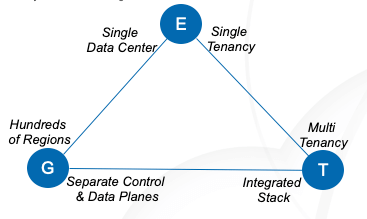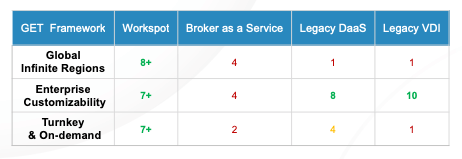“Fast, Good or Cheap – pick two,” is a saying many of us have heard. Less known is the CAP Theorem, which states that a distributed database system can only provide 2 of 3 guarantees: Do you want Consistency, Availability or Partition Tolerance? In either case, you can’t have all three. These triangles illustrate how we’re constantly making tradeoffs as we make decisions – about pretty much everything. Did you know there is a VDI triangle too? It’s part of the GET Framework for VDI Solutions we’ve developed to help IT leaders structure their evaluation of the various approaches to virtual desktops. Hopefully, you’ll find this helpful!
In the VDI world, there are several classes of solutions that take very different approaches:
- Legacy VDI: The customer buys all the components, integrates them, and operates and maintains the VDI solution
- Legacy DaaS: A service provider operates the VDI stack on behalf of the customer
- Broker as a Service: A vendor operates the VDI broker, as a service for its customers, but the customer is still responsible for operating much of the stack
- Cloud Desktops: The vendor provides cloud desktops through a turnkey, SaaS model
While there is no longer much controversy about whether virtual desktops deliver value, it’s not always easy to know what’s possible (and what is not!) with each approach and exactly what questions to ask vendors when you’re evaluating the options. Our new framework can help you dive deep, consider your requirements in the context of what is actually possible today (you might be surprised!), truly understand the tradeoffs you will face, determine your priorities, and know what you can expect from the different approaches. I’ve also outlined the qualifying questions IT leaders should ask vendors so they can be sure that when they select a solution, the unique requirements of all their users are met. So without further ado, here it is – The GET Framework for VDI.
The GET Framework for VDI

How well products stack up against the three primary criteria in the GET Framework for VDI is driven by the architectural decisions vendors make as they build their products. For IT decision makers, understanding the architecture behind the various VDI approaches is critical because if you understand the architecture, it becomes clear what the relative capabilities are of each approach. The GET Framework for VDI Triangle in the next figure illustrates the tension that is created as these architectural decisions are made, and what solution capability tradeoffs customers are forced to make as a result. Let’s explore each dimension.

Critical Architectural Decisions for Cloud VDI
Every VDI vendor has made architecture decisions around characteristics in the GET triangle, and those decisions impact product functionality and whether or not that product meets your requirements. Here’s where the rubber meets the road. To dive into more details of what specific capabilities are enabled (or not), read the Executive Brief: The GET Framework for VDI. Meantime, consider the following:
- Single-Tenant vs. Multi-Tenant: Since enterprise requirements are very customized, it is easiest to meet all those requirements with a single tenant architecture. Most legacy VDI solutions are single tenant solutions, while all successful SaaS solutions are multi-tenant – you can replicate the single tenant stack for a few customers, but that architecture does not scale to thousands or millions of customers. Do you need to be able to easily and quickly scale your cloud desktop solution up and down as business needs change?
- Integrated Stack vs. Separate Control & Data Planes: All successful SaaS solutions are fully integrated solution stacks. Salesforce does not ask you to bring your own database. Workday does not ask you to bring your own UI. But the more you integrate the entire stack in a single data center, the more difficult it becomes to provide the service worldwide. In the case of business SaaS solutions, this is less of an issue, because the vendor can provide great performance by implementing a few copies of the integrated stack in data centers around the world. However, when it comes to virtual desktops, the stakes are completely different, because the proximity of the stack to the end user is key to performance. Therefore, the integrated VDI solution stack would have to be replicated in hundreds of locations around the world to deliver good performance, which is not sustainable from a resource and cost standpoint. So an integrated VDI stack is not the right fit for providing global coverage and outstanding virtual desktop performance. On the other hand, an architecture that separates the control & data plane is well-suited for achieving both global scalability and great performance for users, no matter where they are located geographically. Do you need to support users across different geographies? Do some of your users run GPU-intensive apps?
- Single Data Center/Hundreds of Regions: Since most enterprise software deployments are implemented in only a few data centers, it is easiest to meet the requirements if the solution is architected for a single data center, but in the era of massive compute power, a single data center architecture is a mismatch, because it precludes core capabilities that I imagine you’ll expect to have, such as easy scalability across cloud regions. Today we know that better-than-physical-PC performance is possible, but to achieve it, virtual desktops must be placed close to each end user, and for that, you need a solution that scales horizontally to hundreds of regions. Are all your users within 25 ms of a data center? If not, latency will cause the performance problems for which legacy VDI solutions are notorious.
The GET Scorecard: How Do the Approaches Stack Up?
The bottom line? Here’s the GET Scorecard for VDI solutions. Across the top, we have the four approaches to virtual desktops, and we have the three primary capabilities in the GET Framework for VDI. We’ve scored each of the three primary evaluation criteria for each VDI approach. This should help you quickly focus in on the capabilities that are most important to you, and which VDI approach can best provide them to you. What are your requirements, and which tradeoffs are you willing to make? It’s very difficult, if not impossible, for any one solution to execute perfectly in all three dimensions. Our view of the world is that if your cloud desktop solution does not simplify IT in a way that allows you to reallocate IT resources to strategic projects instead of micromanaging VDI, it’s time to reevaluate. If your cloud desktop solution will not scale horizontally across cloud regions in minutes, it’s time to reevaluate. Those capabilities are what’s going to deliver business agility, and agility is what positions your company for growth. That’s the whole reason you’re moving to the cloud in the first place, right?

The Workspot GET Advantage
Our customers are innovating in ways even our team, with our many years of experience with VDI, didn’t think were possible with virtual desktops; the other available solutions simply can’t get the job done. That’s what customers tell us! Now that doesn’t mean we’re perfect – no solution is – but we are delivering way beyond what is possible with legacy VDI or DaaS, and we are constantly innovating, inspired by our customers’ needs. We’re able to achieve all of this because we have carefully architected our solution to take full advantage of the massive cloud scale that is available today, and in doing so we’ve created a competitive advantage, just like the one we’d like to help you create! For more details, be sure to read the Executive Brief: The GET Framework for VDI Solutions.
If you’re ready to hear more, schedule a quick demo!
IT Strategy




